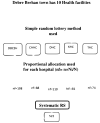Preference of cesarean delivery and its associated factors among pregnant women attending ante natal care at public health facilities of Debrebrehan City, Ethiopia: Cross-sectional study
- PMID: 38295110
- PMCID: PMC10829985
- DOI: 10.1371/journal.pone.0296990
Preference of cesarean delivery and its associated factors among pregnant women attending ante natal care at public health facilities of Debrebrehan City, Ethiopia: Cross-sectional study
Abstract
Background: A Caesarean section is a surgical procedure used to prevent or treat life-threatening maternal or fetal complications. Women's delivery preferences have become a global issue of interest to many researchers and clinicians, especially given the ever-increasing rate of cesarean sections. There is limited data on the preference for cesarean delivery and its associated factors for Ethiopian women, particularly in the study area. The aim of the study is to assess the preference for cesarean delivery and its associated factors among pregnant women attending antenatal care at public health facilities in Debre Berhan, Ethiopia, in 2023.
Methods: An institution-based cross-sectional study design was done from May 5-20, 2023, among 512 participants, and a multi-stage sampling technique was used. The data were collected by using interviewer-administered semi-structured questionnaires. The data were entered by Epi Data version 4.6 and then transferred to SPSS version 25 for analysis. With logistic regression, those variables with a p-value <0.25 in the bivariate analysis were candidates for multivariate logistic regression, and variables with a p-value <0.05 were considered statistically significant.
Result: The preference for a cesarean section was 26%, with a CI of 22.3% to 29.9%. Pregnant mothers who were not satisfied with their previous intrapartum care (AOR; 6.3 CI = (3.5-11), P = 0.01), had no knowledge about cesarean delivery (AOR; 2.9; 95% CI = 1.6-5.3), P = 0.01), had a previous history of spontaneous abortion (AOR; 3.1; 95% CI = (1.5-6.3), P = 0.001), lived in an urban area (AOR; 1.9; 95% CI = (1.0-3.5), P = 0.038), and had a current pregnancy-related problem (AOR; 4.8; 95% CI = 1.9-10), P = 0.001) were significantly associated with the preference for cesarean delivery.
Conclusion: In this study, the preference for cesarean delivery was high as compared to the World Health Organization recommendation. Pregnant mothers who were not satisfied with their previous intrapartum care, had no knowledge about cesarean delivery, had a previous history of spontaneous abortion, had an urban residence, and had a current pregnancy-related problem were significantly associated with a preference for caesarean delivery. Clinicians who are working in the delivery room should improve their service provision by using patient-centered care to increase patient satisfaction.
Copyright: © 2024 Zewudu et al. This is an open access article distributed under the terms of the Creative Commons Attribution License, which permits unrestricted use, distribution, and reproduction in any medium, provided the original author and source are credited.
Conflict of interest statement
The authors have declared that no competing interests exist.
Figures


Similar articles
-
Preference of mode of delivery and associated factors among mothers in East Africa: systematic review and meta-analysis.BMC Pregnancy Childbirth. 2025 Mar 3;25(1):232. doi: 10.1186/s12884-025-07287-8. BMC Pregnancy Childbirth. 2025. PMID: 40033288 Free PMC article.
-
Delivery Mode Preference and Associated Factors among Pregnant Mothers in Harar Regional State, Eastern Ethiopia: A Cross-Sectional Study.Biomed Res Int. 2021 May 10;2021:1751578. doi: 10.1155/2021/1751578. eCollection 2021. Biomed Res Int. 2021. PMID: 34055969 Free PMC article.
-
Maternal satisfaction among vaginal and cesarean section delivery care services in Bahir Dar city health facilities, Northwest Ethiopia: a facility-based comparative cross-sectional study.BMC Pregnancy Childbirth. 2020 Aug 17;20(1):473. doi: 10.1186/s12884-020-03170-w. BMC Pregnancy Childbirth. 2020. PMID: 32807125 Free PMC article.
-
The prevalence of under nutrition and associated factors among pregnant women attending antenatal care service in public hospitals of western Ethiopia.PLoS One. 2023 Jan 17;18(1):e0278180. doi: 10.1371/journal.pone.0278180. eCollection 2023. PLoS One. 2023. PMID: 36649232 Free PMC article.
-
Determinants of maternal near-miss among women admitted to public hospitals in North Shewa Zone, Ethiopia: A case-control study.Front Public Health. 2022 Aug 25;10:996885. doi: 10.3389/fpubh.2022.996885. eCollection 2022. Front Public Health. 2022. PMID: 36091552 Free PMC article. Review.
Cited by
-
Caesarean section delivery and its associated factors in Ghana: A multilevel analysis.PLoS One. 2025 Feb 12;20(2):e0318223. doi: 10.1371/journal.pone.0318223. eCollection 2025. PLoS One. 2025. PMID: 39937831 Free PMC article.
-
Preference of mode of delivery and associated factors among mothers in East Africa: systematic review and meta-analysis.BMC Pregnancy Childbirth. 2025 Mar 3;25(1):232. doi: 10.1186/s12884-025-07287-8. BMC Pregnancy Childbirth. 2025. PMID: 40033288 Free PMC article.
-
Effect of antenatal education on pregnant women`s knowledge, attitude and preferences of delivery mode.BMC Pregnancy Childbirth. 2024 Nov 12;24(1):740. doi: 10.1186/s12884-024-06922-0. BMC Pregnancy Childbirth. 2024. PMID: 39533248 Free PMC article. Clinical Trial.
References
-
- Chelangat C., Kipmerewo M., and Mukabana B., Factors Influencing Women’s Preferred Mode of Delivery in Kericho County Hospitals, Kenya. Global Journal of Health Science, 2021. 13(11): p. 89.
-
- Jalali N., et al.., Pregnant women’s views on the type of delivery: determinants and relationships. پرستاري و مامايي جامع نگر = Journal of Holistic Nursing and Midwifery, 2019. 3(2588–3712).
MeSH terms
LinkOut - more resources
Full Text Sources
Medical

